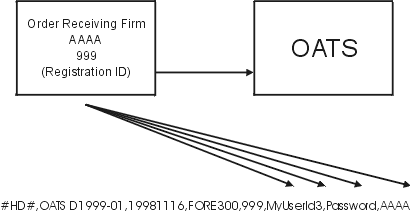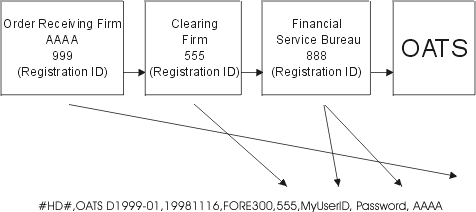OATS Report - April 19, 2001
April 19, 2001
On May 7, 2001, the Order Audit Trail System (OATS) will be instituting functionality that provides member firms with control of who submits OATS data on firms’ behalf. This document includes instructions on to how to build a header record, as well as how to create/maintain the relationships between the firm and its Order Sending Organizations (OSOs).
With the new functionality, the following file validations occur:
- If the FORE file is received, and there is not a relationship between the Transmitting OSO and the member firm, the FORE file is rejected.
- If the FORE file is received, and there is not a relationship between the Transmitting OSO, the Reporting OSO, and the member firm, the FORE file is rejected. This will be done using the MANDATORY Transmitting OSO ID (previously Reporting OSO ID) on the FORE Header Record.
To make the transition to this new functionality, the OATS Technical Team will create the relationships for the member firms, based on data submitted over the past 30 days. If you need to create a new Firm-OSO Relationship (a relationship that does not exist 30 days prior to 5/7/2001), please consult the OATS Subscriber Manual. If you are a new member firm, you must create your own relationships if you plan to begin submitting data after 5/7/2001.
Provided below are definitions of the relationships, as well as reporting scenarios, and how to populate the FORE Header Record.
Transmitting OSO packages FORE files and physically transfers order data to OATS via FTP, CONNECT:Direct, e-mail, or the Web interface.
Reporting OSO is authorized to view the Order Receiving Firm’s data, including file status, statistics, and record rejections. For example, the Reporting OSO may be a clearing firm that is responsible for repairing rejected records on behalf of the Order Receiving Firm.
Header Records
Header records will continue to be used to identify and authenticate files and the firms submitting files. A header identifies the Order Receiving Firm, which is the firm that is the subject of reporting; the Transmitting OSO, which packages FORE files and physically transfers order data to OATS; and the Reporting OSO, a third party that is authorized to view, submit, or repair the Order Receiving Firm’s data. (For example, a Reporting OSO could be a clearing firm with responsibilities to repair rejections for the Order Receiving Firm.)
The header consists of a record type, Version Description, Generation Date, Firm FORE ID, Reporting OSO ID, User ID, Password, Order Receiving Firm MP ID, and an end of record marker.
Header Example
#HD#,OATS D1999-01,19981008,MyFirmFOREID,Transmitting OSOID,Myuserid,Mypassword,MPID
NOTE: User ID and password fields are not required in the header of FOREs sent via FTP or CONNECT:Direct, but are required in the header of FOREs sent via e-mail.
Transmitting OSOs must submit a separate FORE for each combination of Order Receiving Firm MP ID and Reporting OSO ID. The Order Receiving Firm, Transmitting OSO, and Reporting OSO all have access to any records contained in the FORE. If no Reporting OSO is designated, only the Transmitting OSO and the Order Receiving Firm have access to the records in the FORE. Multiple FOREs can be packaged in a single file.
An NASD member firm subject to order reporting rules is not required to designate a Reporting OSO; however, a member firm may designate more than one Reporting OSO, employing one organization for the handling of a portion of its records (e.g., institutional orders) and another for other records (e.g., retail orders). There may only be one Transmitting OSO and one Reporting OSO associated with each FORE.
The following figures illustrate some possible scenarios by showing how records in the FORE header would identify the separate organizations and their roles. In Scenario 1, the Order Receiving Firm acts as its own Transmitting OSO. In Scenario 2, the Transmitting OSO (financial service bureau) sends the Order Receiving Firm’s data to OATS. In Scenario 3, a clearing firm reports on behalf of an Order Receiving Firm via a financial service bureau.
OSO Scenario 1

OSO Scenario 2

OSO Scenario 3

Note: For the scenario above, member firms must have relationships built in OATS for both the Transmitting and Reporting firms. Please see the OATS Subscriber Manual for details.
The header also is used to set the delimiter character to be used for the remainder of the FORE. The delimiter character is determined by the fifth character in the header, which follows the four character record type code "#HD#". The delimiters are restricted to one of the following ASCII characters: (comma (,), semicolon (;), pipe (|), tab (-->)).
Each header record must be terminated by an end of record marker, which can be either a single ASCII LF character, or the combination ASCII CR/LF.
If you have any questions regarding this article or OATS in general, please call (800) 321-NASD.
